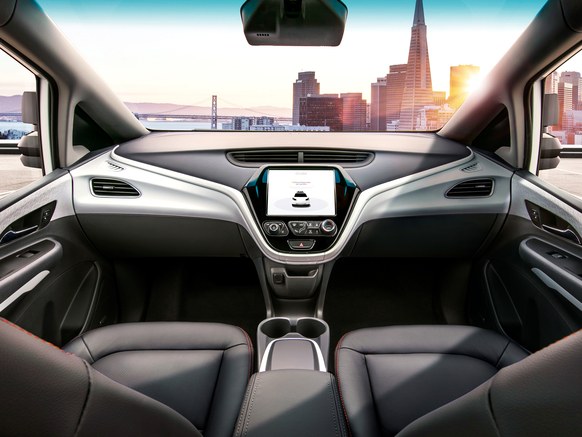
Robohub.org
The GM/Cruise robocar interior is refreshingly spartan

GM revealed photos of what they say is the production form of their self-driving car based on the Chevy Bolt and Cruise software. They say it will be released next year, making it almost surely the first release from a major car company if they make it.
As reported in their press release and other sources their goals are ambitious. While Waymo is the clear leader, it has deployed in Phoenix, because that is probably the easiest big city for driving in the USA. Cruise/GM claims they have been working on the harder problem of a dense city like San Francisco.
What’s notable, though, about the Cruise picture is what’s not in it, namely much in the way of dashboard or controls. There is a small screen, and a few controls but little else. Likewise the Waymo 3rd generation “Firefly” car had almost no controls at all.
The car has climate controls and window controls and little else. Of course a touchscreen can control a lot of other things, especially when the “driver” does not have to watch the road.
Combine this with the concept Smart-car self-driving interior from Daimler below, and you see a change in the thinking of the car industry towards the thinking of the high-tech industry.
At most car conferences today, a large fraction of what you see is related to putting new things inside the car — fancier infotainment tools and other aspects of the “connected car.” These are the same companies who charge you $2,000 to put a navigation system into your car that you will turn off in 2 years because your phone does a better job.
It is not surprising that Google expects you to get your music, entertainment and connectivity from the device in your pocket — they make Android. It is a bigger step for GM and Daimler to realize this, and bodes well for them.

While the car is not finalized and the software certainly isn’t, GM feels it has settled on the hardware design of its version 1 car, and is going into production on it. I suspect they will make changes and tweaks as new sensors come down the pipeline, but traditionally car companies have always locked down the main elements of the hardware design a couple of years before a vehicle is available for sale.
One thing both of these cars need more of, which I know well from road tripping, is surfaces and places to put stuff. Cupholders and door pockets aren’t enough when a car is a work or relaxation station rather than something to drive.
What is not clear is if they have been bold enough to get rid of many of the other features not needed if you’re not driving, like fancy adjustable seats. The side-view mirrors are gone but sensors are in their place (it is widely anticipated that they will allow even human driven cars to replace the mirrors with cameras, since that’s better and lower drag.) Waymo’s firefly had the mirrors because the law still demands them.
GM is also already working with NHTSA to get this car an exception to the Federal Motor Vehicle Safety Standards which require the things like the steering wheel that they took out. The feds say they will work quickly on this so it seems likely. Several states are already preparing the legal regime necessary, and GM suggests it will deploy something in 2019.
Not too long ago, I would have ranked GM very far down on the list of carmakers likely to succeed in the robocar world. After they acquired Cruise they moved up the chart, but frankly I had been skeptical about how much a small startup, no matter how highly valued, could change a giant automaker. It now seems that intuition was wrong.




